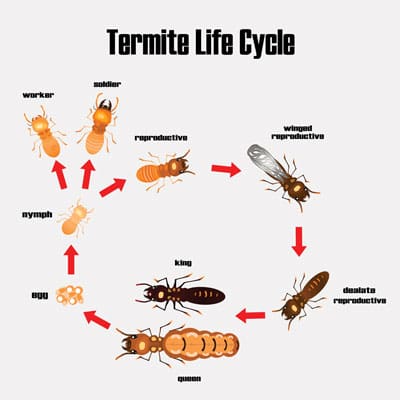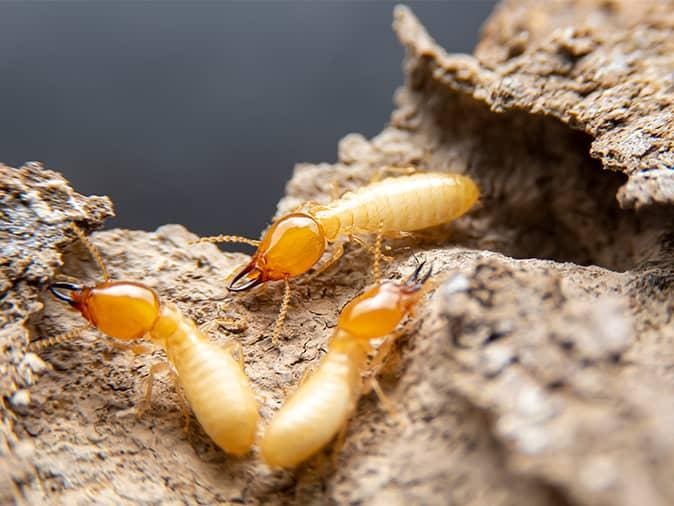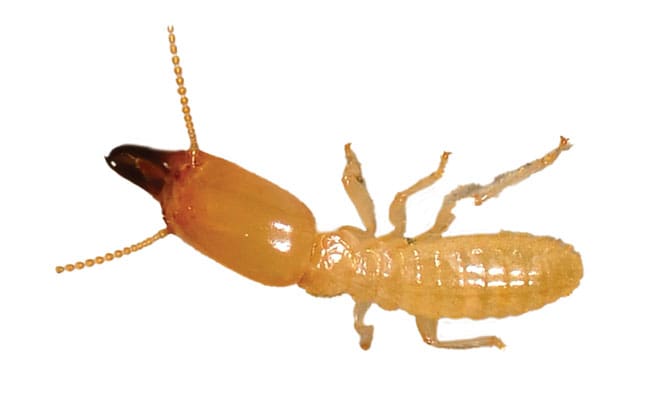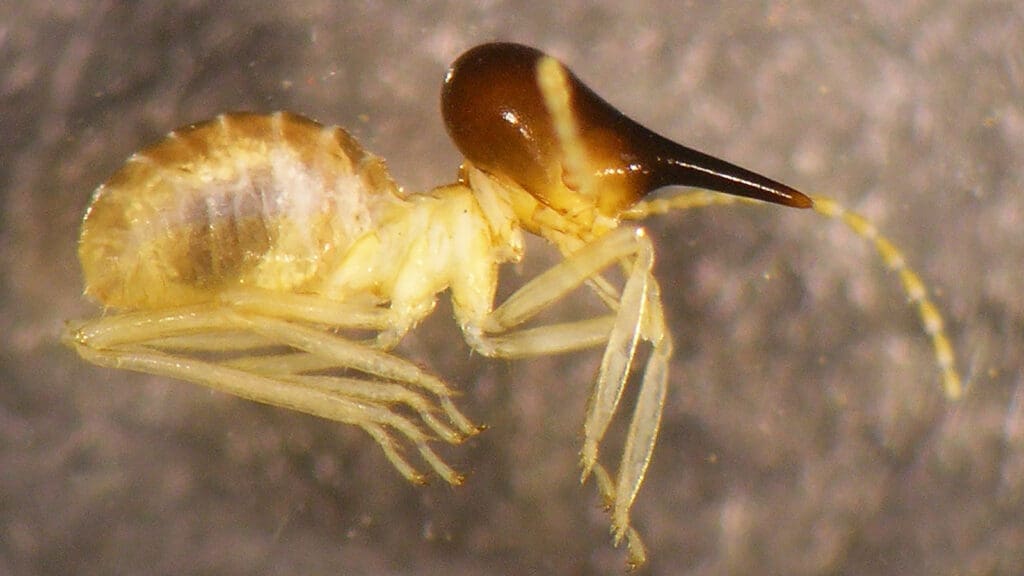Termites may be small, but their ability to wreak havoc on homes and structures is immense. In this article, we delve into the fascinating world of termites and explore the intricate workings of their colonies. From the intricate hierarchy of their social structure to the destructive power of their insatiable appetite, you will gain a deeper understanding of these silent invaders. Join us as we venture into the hidden world of termites, uncovering their habits, behaviors, and the most effective strategies to protect your property from their destructive grasp.

Introduction to Termites
What are termites?
Termites are small, social insects that belong to the order Isoptera. They are commonly known for their ability to consume cellulose, a complex carbohydrate found in plant materials such as wood and grass. Termites are highly organized creatures that live in large colonies with specialized castes, each with its own specific roles and responsibilities. Understanding the behavior and biology of termites is crucial for effective termite control and prevention.
Importance of understanding termite colonies
Termites play a significant role in ecosystems, but they can also cause extensive damage to man-made structures. Having a thorough understanding of termite colonies is essential for implementing effective pest control strategies. By knowing how termites communicate, build their nests, and carry out their responsibilities, we can develop targeted approaches to control and mitigate termite infestations. This knowledge is crucial for homeowners, property managers, and pest control professionals alike in order to protect our homes, gardens, and structures from costly damage.
The Termite Society
Social structure of termites
Termites display a complex social structure, similar to other eusocial insects like ants and bees. The colony is composed of different castes that each perform specialized tasks for the survival and growth of the colony. The queen is the central figure in the termite society and is responsible for reproduction. Workers make up the majority of the colony and are responsible for tasks such as foraging, nest construction, and feeding the other members. Soldiers have a protective role, defending the colony against predators, while reproductive termites are responsible for creating new colonies.
Different roles within a termite colony
Each caste within a termite colony has specific tasks and responsibilities. The queen’s sole purpose is to lay eggs, ensuring the continuity of the termite colony. The workers, as the name suggests, perform most of the labor-intensive tasks. They are responsible for constructing and maintaining the nest, foraging for food, and nurturing the other members of the colony. Soldiers have large heads and powerful jaws, making them well-suited for defending the colony against potential threats. Reproductive termites, referred to as alates, have wings and are responsible for establishing new colonies through nuptial flights.

Termite Castes
Worker termites
Worker termites form the largest caste in the termite colony. They are blind and wingless, with soft bodies that allow them to navigate through narrow tunnels and galleries within the nest. Workers are responsible for a variety of tasks, including foraging for food sources, building and maintaining the termite nest, and caring for the young and other members of the colony. They significantly contribute to the overall functioning and survival of the termite society.
Soldier termites
Soldier termites have distinct physical features that differentiate them from other castes. They possess enlarged heads and strong jaws called mandibles, which they use to defend the colony against invaders. Soldiers are responsible for protecting the colony from potential threats, such as ants or other predators that may attempt to invade the nest. Although they cannot reproduce or feed themselves, soldiers play a vital role in the defense and security of the termite society.
Reproductive termites
Reproductive termites, also known as alates, are responsible for the expansion and establishment of new termite colonies. These individuals are winged and leave the original colony during nuptial flights to mate with other alates from different colonies. Once the mating process is complete, the female alates shed their wings and become queens of their newly formed colonies. The reproductive termites are crucial for the survival and growth of termite populations, as they ensure genetic diversity and the continuation of the species.
Termite Colony Development
Nuptial flight
Nuptial flight is a crucial stage in the reproductive cycle of termites. During this process, reproductive termites leave the original colony in large numbers to search for mates from other colonies. Nuptial flights typically occur after a period of warm, humid weather, often during spring or early summer. The alates take to the air and fly for varying distances before landing, shedding their wings, and seeking suitable locations to establish new colonies.
Establishing a new colony
After the nuptial flight, the mated female alates seek a suitable nesting location to establish a new termite colony. They typically burrow into wood, soil, or other appropriate materials to create a safe and stable environment for colony development. The female alate becomes the queen and begins reproducing, laying eggs that will eventually hatch into worker termites. The initial stages of colony establishment are critical, as the new colony must secure nutrition sources and establish a functional nest.
Maturation and expansion of the colony
As the termite colony matures, the queen continues to lay eggs and the workforce of workers grows. The workers are responsible for expanding the nest, constructing tunnels, and maintaining the overall structure. The growth of the colony enables the termites to explore new food sources, which can include wood, grass, or other plant materials. Over time, the colony can expand to accommodate thousands or even millions of termites, creating a complex system of interdependent individuals.

Termite Nest Construction
Different types of termite nests
Termites construct various types of nests depending on the species and environmental conditions. Some termites create mounds aboveground, while others build nests underground or within the wood they consume. Mound-building species, often found in tropical regions, create large, visible mounds that can rise several feet above the ground. In contrast, ground-dwelling species construct their nests in the soil and create elaborate tunnel systems that connect to foraging areas. Wood-damaging termites build their nests within the wood they consume, constructing galleries and chambers as they tunnel through the material.
Composition and architecture of termite nests
Termite nests are complex structures composed of various materials, including soil, wood, saliva, and feces. The composition and architecture of the nest vary depending on the termite species and ecological factors. Mound-building termites, for example, use a combination of soil, saliva, and organic matter to construct their mounds. The nest architecture is designed to provide optimal conditions for the growth and survival of the colony, including temperature and humidity regulation, protection from predators, and efficient food storage and distribution.
Termite Diet
Cellulose consumption
Termites are renowned for their ability to consume cellulose, a substance found in plant cell walls. Cellulose is a complex carbohydrate that provides the main source of nutrition for termites. They have evolved specialized enzymes and gut microbiota that allow them to break down cellulose into simpler forms that can be digested and utilized for energy. Termites play a crucial role in ecosystem functioning by decomposing dead plant material, aiding in nutrient recycling.
Symbiotic relationship with gut microbiota
Termites owe their ability to digest cellulose to a symbiotic relationship with microorganisms in their digestive system. They house a diverse community of bacteria, archaea, protists, and fungi within their hindgut, collectively known as the gut microbiota. These microorganisms produce enzymes capable of breaking down cellulose, hemicellulose, and lignin, which are indigestible by the termite alone. The termite provides a suitable environment and resources for the gut microbiota, while they, in turn, contribute to the digestion of cellulose and the production of essential nutrients for the termite.

Termite Communication
Chemical communication
Termites rely heavily on chemical communication to coordinate their behaviors and maintain social cohesion within the colony. They produce and detect a wide array of chemical signals known as pheromones. Pheromones are chemical substances released by an individual and perceived by others of the same species, eliciting specific behavioral responses. Termites use pheromones to mark trail paths, denote nestmate recognition, indicate alarm or distress, and relay messages related to reproduction. Chemical communication is crucial for the efficient functioning and organization of termite colonies.
Pheromones and their role
Pheromones play a significant role in termite society by regulating caste differentiation, reproductive behavior, foraging activities, and the division of labor within the colony. For example, the queen emits pheromones that suppress the reproductive capabilities of other female workers, ensuring her dominance and exclusive right to reproduce. Soldiers release alarm pheromones when they perceive a threat, alerting other colony members to potential danger. In this way, pheromones serve as a means of communication and coordination among termites, enabling them to adapt to changing environmental conditions and respond collectively to external stimuli.
Other forms of termite communication
While chemical communication is the primary means of communication for termites, they also employ other forms of communication to exchange information within the colony. For instance, termites use vibrations or drumming to communicate over short distances, signaling alarm or attracting attention. Additionally, termites can engage in trophallaxis, a process in which individuals exchange oral secretions, transferring nutrients and information between colony members. These various modes of communication facilitate efficient coordination and cooperation among termites, contributing to the overall success and survival of the colony.
Termite Defense Mechanisms
Soldier termites and their role in defense
Soldier termites form the frontline defense against potential threats to the colony. Their enlarged heads and mandibles are specifically adapted for combat, enabling them to fend off predators or invaders. Soldiers typically have specialized defensive behaviors, such as blocking entrances or mounting physical attacks on intruders. They release alarm pheromones when under attack, alerting other colony members to join in the defense. The presence of soldier termites and their vigilant defense mechanisms significantly enhance the colony’s ability to protect itself from outside dangers.
Structural adaptations for protection
Termites have evolved various structural adaptations to improve their defense against potential threats. One notable example is the construction of hard and durable architectural features within the nest, such as hardening gallery walls or building tunnels with multiple entrances and exits. These structural adaptations serve as physical barriers and provide a degree of protection against predators and other external dangers. Additionally, termites often build their nests in hidden or inaccessible locations, such as underground or within the wood they consume, further enhancing their protection against detection and attack.
Chemical defenses against predators
Termites are not only adept at physical defense but also employ chemical defenses to repel or deter predators. Many termite species produce toxic or repellent substances that discourage predators from attacking or consuming them. These chemical defenses can include foul-smelling secretions, noxious gases, or even venom injected through specialized structures. By incorporating chemical defenses into their repertoire, termites can effectively deter potential predators and increase their chances of survival and colony growth.

Termite Damage
Extent of termite damage
Termite damage can be extensive and costly, posing a significant threat to structures, furniture, and wooden objects. Termites have the ability to consume vast quantities of wood, compromising the structural integrity and safety of buildings. If left unchecked, termite infestations can lead to costly repairs and potentially render a structure uninhabitable. The extent of termite damage can vary depending on factors such as termite species, environmental conditions, and the duration of the infestation.
Economic impact of termite infestation
Termite infestations can have severe economic consequences, particularly in the real estate and construction industries. The repair costs associated with termite damage can be substantial, often requiring extensive renovations or even complete structural replacements. Additionally, termite infestations can devalue properties and make them less attractive to potential buyers or tenants. Regular termite inspections, timely detection, and effective pest control measures are essential for minimizing the economic impact of termite infestations.
Signs of termite damage
Recognizing the signs of termite damage is crucial for early detection and prompt action. Some common indicators of termite activity include:
- Mud tubes or tunnels on the foundation or walls, used by termites to move between the nest and food sources.
- Hollow or damaged wood, particularly in concealed areas such as attics, basements, or crawl spaces.
- Frass, termite droppings that resemble sawdust or tiny pellets, often found near termite galleries or exit holes.
- Swarming termites or discarded wings, which may indicate the presence of reproductive termites and the potential for a new colony.
Conclusion
Summary of key points
Termites are social insects that form highly organized colonies with specialized castes. Their social structure, including worker termites, soldier termites, and reproductive termites, enables efficient division of labor for colony survival and growth. Termites construct nests of various types, using materials such as soil, wood, saliva, and feces, creating complex architectural structures tailored to their needs. Communication within termite colonies relies heavily on chemical signaling, primarily through the use of pheromones, but also involves other forms such as vibrations and trophallaxis. Termites have developed defense mechanisms, including soldier termites, structural adaptations, and chemical defenses, to protect their colony from predators. Understanding termite behavior and damage is crucial for effective termite control and prevention to minimize the economic impact and safeguard structures.
Importance of proper termite control
Proper termite control is essential for protecting homes, buildings, and wooden structures from the devastating effects of termite damage. Early detection, regular inspections, and proactive pest control measures are crucial for preventing infestations and minimizing the economic consequences of termite damage. By understanding the biology, behavior, and communication strategies of termites, we can develop effective pest control solutions that help preserve our properties and promote a harmonious coexistence with these fascinating insects.

I am Randy, the author behind PestControld.com. Drawing from decades of experience, I aim to provide valuable insights, expert advice, and practical recommendations to help you make informed decisions when assessing viable pest control solutions.